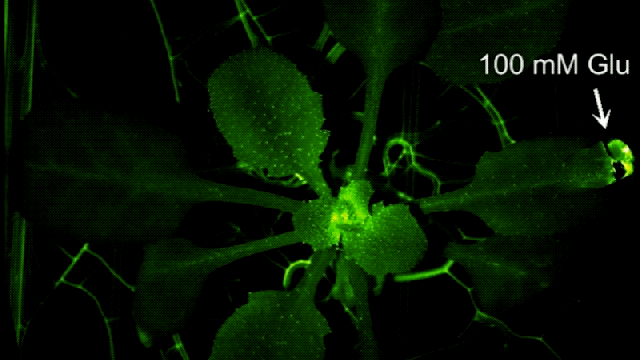We tend to think of plants as helpless, passive green blobs, but a fascinating new study, in which scientists used fluorescent light to visualise alarm signals within plants, shows how our photosynthesising friends are able to mobilise their defences.
New research published today in Science is providing an unprecedented view of the signalling action that happens within plants when they’re under attack.
A second or two after a plant receives an injury, such as a chomp from a caterpillar, a warning signal radiates from the location of the wound, spreading out through the entire plant in a process that takes fewer than 120 seconds. The plant, now aware that it’s under attack — or at least, as “aware” as a plant can be — can respond to the threat by releasing chemical countermeasures.
Scientists have known about this system-wide signalling system for quite some time, but the new study, conducted by researchers from the University of Wisconsin-Madison, the Japan Science and Technology Agency, and several other institutions, is the first to show this remarkable defence mechanism in action.
What’s more, the study offers new insights into the biological processes behind this nervous system-like signalling, which is still poorly understood.
“We do know that if you wound a leaf, you get an electrical charge, and you get a propagation that moves across the plant,” botanist Simon Gilroy, a professor at UWM and a co-author of the new study, said in a statement. “What triggered that electric charge, and how it moved throughout the plant, were unknown.”
Gilroy and his colleague Masatsugu Toyota, who led the research, suspected calcium had something to do with it. Calcium ions, which produce an electrical charge, are known to perform signalling duties in plants, particularly in response to changing environmental conditions.
Scientists have struggled to visualise this movement within plants, leading to a rather fascinating solution. To watch the calcium move in real time, Toyota and his colleagues bioengineered plants to produce a protein that fluoresces around calcium, lighting up the interiors of plants like a Christmas tree.
Using advanced microscopes and biosensors, the researchers were able to track the presence and volume of the calcium in response to various injuries, including caterpillar chomps, scissor snips, and damage caused by crushing.
While experimenting on mustard plants, the researchers watched the plants light up as the calcium surged away from the injury and toward their other leaves. The signal propagated at a rate of 1mm per second, which is fast enough to reach the far corners of the plant in less than two minutes. The calcium pulses were able to spread by travelling through the plant’s vascular, or circulatory, system.
After the warning signal had fully propagated, the leaves began to release their defence-related hormones in preparation for future attacks. Plants, in addition to releasing chemicals that kickstart the repair process, can release noxious, insect-unfriendly chemicals.
This latest research expands upon the work done by Swiss scientist Ted Farmer, who previously showed that defence-related electrical signals depend on glutamate — an important neurotransmitter in mammals and a signalling agent in plants.
In a secondary experiment, Toyota and his colleagues demonstrated that long-distance signalling disappears in plants that have had their glutamate-releasing powers taken away from them, via two specific genetic mutations. This strongly suggests that glutamate, when released at the site of an injury, triggers the burst in calcium — a previously undocumented action in plants.
Writing in an accompanying Science: Insights article, biologists Gloria Muday and Heather Brown-Harding said the researchers need to conduct future experiments to prove that it isn’t the glutamate that’s moving long distances around the plant, rather than the proposed calcium.
Pretty amazing for an immobile organism without a central nervous system. Plants can’t run away, or gnash back with tooth and claw, but they aren’t completely defenceless, either.
[Science]
